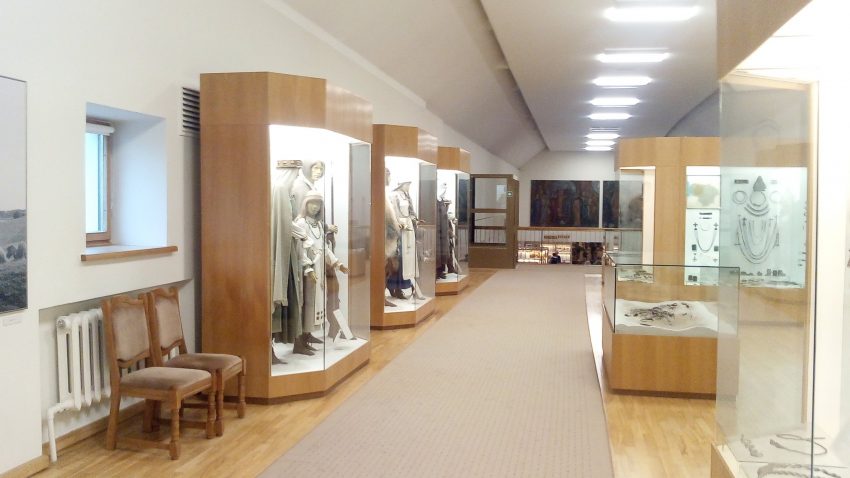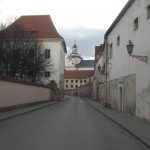
At the Church of the Holy Spirit, a Dominican monastery was established on St. Ignatius Street in 1501. In the 19th century, the buildings of the monastery were converted into a prison The entrance from St. Ignatius Street to the former old Jesuit Novitiate: arranged around three courtyards. It is the same age as the nearby Church of St. IgnatiusThe Church of St. Ignatius was erected from 1622 to 1647 being devastated by fires in 1748-1750. It suffered during the war against Russia from 1655 to 1661. The porch was added in the 19th century.All photos are copyrighted by Vladislav B. Sotirovic© Vladislav B. Sotirovic 2020
Continue Reading

The silver cofin of St. Casimir is under a plaster canopy accompanied by relics. Under the cofin is a miraculous painting in a silver frame, with a silver statue with the saint's attributes placed on the cofin. The relief features a very rare depiction of a smiling Blessed Virgin Mary with Baby JesusIn the chapel there are eight silver-plated wooden Baroque statues of the Kings and Grand Dukes of Poland and Lithuania from the Gediminid and Jagiellon dynasties from the 17th centuryThree-Handed Image of St. Casimir c. 1520. This painting is considered to be miraculous. In 1743 the painting was put into a silver, gold-plated framing. St. Casimir is holding lilies and a rosary, which are his symbolsAll photos are copyrighted by Vladislav B. Sotirovic© Vladislav B. Sotirovic 2020
Continue Reading
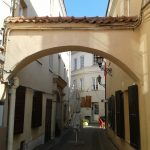
A building of Jewish Center of Culture and Information in the area of the Large Jewish Ghetto in 1941-1943. In this house a famous Vilnius resident Dr. Tzemach Shabad livedTzemach Shabad (1864-1935) was not only a good doctor, but a societal and community figure, and humanist as well. A monument (in 2007 erected) to him on the territory of WWII Large Jewish GhettoA plaque of a plan of the Jewish Ghetto in 1941-1943. There were Small and Large Jewish Ghettos existing from September 6th, 1941 to September 23rd, 1943. Today, September 23rd is the National Memorial Day for the Holocaust/Genocide of the Lithuanian Jews All photos are copyrighted by Vladislav B. Sotirovic© Vladislav B. Sotirovic 2019
Continue Reading
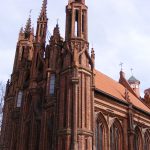
Church of St. Anne (left) and Bernardine Church (right). The church of St. Anne is a unique monument of red firebrick Gothic architecture in LithuaniaSt. Anne Church, designed in 1495-1500 by Benedikt Rejt, built up at the turn of the 15th century, and renovated in 1902-1909. 35 different kinds of brick were used help in creating the church. The façade was reinforced in 1960-1970St. Anne Church - a church which French Emperor Napoleon Bonaparte wanted to put on his palm and carry it over to Paris. The Church of St. Anne is symmetrical, marked by graceful, pointed forms that continue upwardAll photos are copyrighted by Vladislav B. Sotirovic© Vladislav B. Sotirovic 2018
Continue Reading
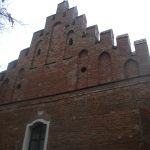
The church was named after St. Nicholas, who was the Bishop of Myra and the patron of travelers and merchants. The character of Santa Claus is thought to be based on this saintThe Church of St. Nicholas in Vilnius is the oldest surviving Late Gothic church in Lithuania. The small church was used by the Franciscan monks, who lived nearbyThe interior of the church is decorated with ornate rib and groin vaults. A 16th-century picture of St. Nicholas with a silver frame is located on the left altarAll photos are copyrighted by Vladislav B. Sotirovic© Vladislav B. Sotirovic 2018
Continue Reading

The architect Michail Prozorov designed the rectangular building with three-walled apse according to the requirements of Karaim liturgyThe oriental-style exterior has a protruding central part and the onion-shaped dome over it. The distinctive exterior of the building emphasises its unique purposeIn 1949, the Kenessa, along with many other sacral buildings, was nationalized and closed down. In 1988, it was returned to the Karaim community. In 1993, it was re-consecrated and has remained open sinceAll photos are copyrighted by Vladislav B. Sotirovic© Vladislav B. Sotirovic 2020
Continue Reading
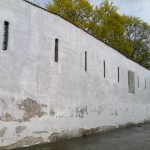
It was not until 1503 when Grand Duke of Lithuania and King of Poland Alexander Jagiellon granted a privilege that the construction of the wall began. The year 1522 is considered to mark the end of the construction, when Grand Duke of Lithuania Sigismund the Old exempted the residents of Vilnius from the duty of keeping guard at the castle and ordered 24 guards to be posted at the city gatesThe length of the defensive wall was 2,5 kilometres having 10 gates. The wall surrounded the territory of today's Old Town, approximatelly 100 hectars. The foundation of the defensive wall was built of stone, and bricks were mainly used at the level of loopholes and higher. The was was adapted for defence with gunpoweder-operated firearms Until the late-18th century, the Vilnius defensive wall was frequently renovated. The wall served for the last time in 1794 during the uprising led by ...
Continue Reading
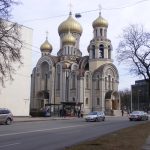
It is one of the most attractive Russian Orthodox churches in Vilnius: the exterior is a profusion of shining onion-shape domes; but the interior is remarkably serene. The interior's simplicity is interupted only by an elaborate iconostasis The internal space is created by two huge pairs of parallel semi-circular arches, intersecting at the top under the central dome which is also the main source of lightA panel on the right of the iconostatis depicts the two saints, both from noble families in the Middle Ages, to whom the church is dedicatedAll photos are copyrighted by Vladislav B. Sotirovic© Vladislav B. Sotirovic 2020
Continue Reading
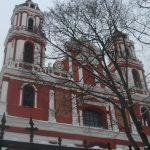
The church was built on the north side of the Lukiškių Square in 1624. However, the present building dates from the late 17th-18th cent.It is a single-nave Baroque church with cylindrical vaults. An image of the miraculous painting of the 18th century high altar occupies the niche above the porticoThe niches hold wooden 18th cent. statues of St. Hyacinth and St. Dominic. During the Soviet times there were designs to demolish the church but it did not ever happenAll photos are copyrighted by Vladislav B. Sotirovic© Vladislav B. Sotirovic 2018
Continue Reading
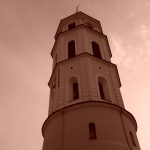
Its foundations are superimposed on the remains of a square tower, one of the oldest brick buildings in Lithuania, whose bricks are bound in the pre-Cothis (Baltic) manner An oval four-story tower with loopholes was built on these remains. Originally, it was a defensive tower of the Lower CastleThe underground square part dates from the 13th century, and the round part - from the late 14th century All photos are copyrighted by Vladislav B. Sotirovic© Vladislav B. Sotirovic 2019
Continue Reading
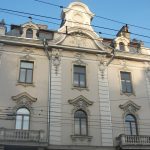
Beside the main house (close to the Antakalnio St.) stands a residential house, in which the first exhibition of Lithuanian art took place in 1907A monument to the brothers Vileišis in Vilnius near the River NerisThe main Vileišis building was one of the first in Vilnius, for whose construction a rare material in Lithuania - concrete - was used. The main house was built in 1904-1906 by the Lithuanian businessman and public figure Petras Vileišis according to a design by engineer August Klein All photos are copyrighted by Vladislav B. Sotirovic© Vladislav B. Sotirovic 2018
Continue Reading

The courtyard of the palace. In 1834 the building was reconstructed and acquired its present appearance. In 1919 it was given to the university and was home to several well-known professors The façade is harmonious, moderately decorated. The façades of the servants' house facing the courtyard and Bokšto Str. (No. 5) Today the palace houses the Vilnius Picture Gallery and the Lithuanian Art MuseumAll photos are copyrighted by Vladislav B. Sotirovic© Vladislav B. Sotirovic 2019
Continue Reading

Trakų St. finishes where it meets Pylimo St, which runs along the course of the old city wall. There used to be a gate here, which was pulled down together with the wall at the very beginning of the 19th century. In the niche of the Umiastowski estate (Trakų St. 2) there is a Statue of "The City Guard" (1973) In Trakų Street, there is the Church of Our Lady of the Assumption that was founded here by the noble Goštautas family in 1387, the same year as Lithuania became converted to Christianity. However, it is believed that the church with the monastery existed even earlierOne of courtyards of the buildings in Trakų StreetAll photos are copyrighted by Vladislav B. Sotirovic© Vladislav B. Sotirovic 2020
Continue Reading

One of the focal touristic attractions in the Žvėrynas district of Vilnius is the traditional type of the wooden houses coloured in different coloursŽvėrynas means "menagerie" or "beastland". In the 19th century a forest grew in this areaSince 1893, the process of urbanization of the district of Žvėrynas started with the building of wooden and brick villas and summerhouses. Today, this district of Vilnius is a prestigiuos residential part of the capitalAll photos are copyrighted by Vladislav B. Sotirovic© Vladislav B. Sotirovic 2020
Continue Reading

The Galera Gallery in the Užupis Art Incubator also operates there, where exhibitions of various kinds of art are organizedGalera of Užupis is an Alternative art gallery. That is a place similar to the former Christiana district in Copenhagen in DenmarkThe Užupis district and its Art Incubator are separated from the Old Town in Vilnius on three sides by the River Vilnia, and by a high hill on the fourth sideAll photos are copyrighted by Vladislav B. Sotirovic© Vladislav B. Sotirovic 2020
Continue Reading

Simonas Daukantas was one of the first authors to start forming the concept of an ethnic Lithuanian nation and its cultural history. The first book on the history of Lithuania "The Deeds of Ancient Lithuanians and Samogitians" was written by Simonas Daukantas (1793-1864) in 1822 while he was still studying at Vilnius UniversityThe larger part of the premises in this courtyard belongs to the Faculty of Philology. The Institute of Foreign Languages is located here too"Domus Philologiae" with the lobby of Muses on the first floor of the east wing is decorated by a fresco created by Rimtautas Gibavičius in 1969All photos are copyrighted by Vladislav B. Sotirovic© Vladislav B. Sotirovic 2018
Continue Reading

After being baptized in 1251 into the Roman Catholicism in 1251, Grand Duke Mindaugas built the first cathedral in Vilnius on the site of the present-day Cathedral Basilica (Cathedral of St. Stanislaus and St. Vladislaus). Before that, in pagan times an altar, a sacred fire or even a Perkūnas sanctuary was located on the site of today's Cathedral Basilica The creation of the Lithuanian state started as late as the 13th century. Its first outstanding ruler Mindaugas was baptized in 1251 and crowned King of Lithuania on July 6th, 1253. Today, July 6th is a national holiday of Lithuanian statehood It is assumed that it was Mindaugas who built the first Cathedral in Vilnius. Traces of the original Cathedral incorporating Romanesque style features have been discovered in the vaults of the present Cathedral. After Mindaugas's death, the Christian (Roman Catholic) Cathedral was turned into a place of pagan worship. The author ...
Continue Reading

New Trakai is one of Lithuania's loveliest towns. It stretches out along a narrow peninsula between lakes, and it is a frequent destination for Vilnius residents, and visitors from abroad The largest lakes, such as Galvė, Skaistis, Bernardinai, and Totoriškės are connected together. Lake salmon breed in Lake AkmenaThe Trakai Historical National Park was included in the preliminary UNESCO World Heritage List in 2003. Trakai was Lithuania's second capital in Middle Ages. Its time of glory began under Grand Duke Vytautas the Great, who strengthened the Peninsula Castle, and built the most famous monument of Lithuania's ancient history - the Island CastleAll photos are copyrighted by Vladislav B. Sotirovic© Vladislav B. Sotirovic 2019
Continue Reading

Šiltadaržio St. is ending at Bernardinų St.Art Printing House Culture Center with the Theater in the streetIn the streeet, there is a Toy Museum and other cultural atractionsAll photos are copyrighted by Vladislav B. Sotirovic© Vladislav B. Sotirovic 2020
Continue Reading
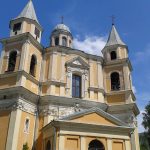
The interior sculptural décor was created by Pietro Perti (Italian master) in 1700-1705. Twin towers were built on in the 18th century. It was built by the efforts of Casimir Sapieha the Younger (1637-1720) in 1694-1717 On the façade frieze two Christian soldiers taken into captivity by the Muslims are represented. The main goal of the Trinitarian Order was returning such captives to their homelands The church has an impressive cupola (dome), the interior is adorned with stucco relief works and sculptures - a large part of them is survived. The church is a "sister" to the Church of St. Peter and St Paul in Vilnius (Antakalnis)All photos are copyrighted by Vladislav B. Sotirovic© Vladislav B. Sotirovic 2019
Continue Reading
 The museum is located in the north wing of the Old Arsenal and looks at Neolithic, Bronze and Iron Age Lithuania followed by the various tribes that inhabited the area until they combined to form a state in the 13th century
The museum is located in the north wing of the Old Arsenal and looks at Neolithic, Bronze and Iron Age Lithuania followed by the various tribes that inhabited the area until they combined to form a state in the 13th century The museum displays object found in burial sites, such as pins, amulets, rings, brooches, knives or necklaces. You can as well as see regional dressses of Lithuanian tribes before the formation of the state in the mid-13th century
The museum displays object found in burial sites, such as pins, amulets, rings, brooches, knives or necklaces. You can as well as see regional dressses of Lithuanian tribes before the formation of the state in the mid-13th century  The museum shows a hoard of some 16.000 17th-century coins found in 1999 in Vilnius. It is believed that the hoard may have been hidden during the 1700-1721 Great Northen War. Nevertheless, it is the largest collection of old coins to be found in Lithuania
The museum shows a hoard of some 16.000 17th-century coins found in 1999 in Vilnius. It is believed that the hoard may have been hidden during the 1700-1721 Great Northen War. Nevertheless, it is the largest collection of old coins to be found in Lithuania 




















